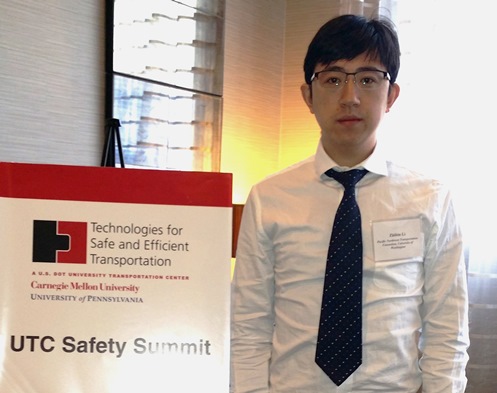PacTrans News
-
March 24, 2015
PacTrans Attends UTC Safety Summit
PacTrans joined safety-focused University Transportation Centers (UTC) from across the country in Pittsburgh for the Summit of University Transportation Centers for Safety: Working in partnership to address real world transportation problems. From March 19 – 20, government and industry leaders and UTC officials learned about UTC research and education efforts, as well as government interests and industry needs in these areas. The summit featured keynote speaker Greg Winfree, US DOT Assistant Secretary for Research and Technology, as well as agency and industry representatives speaking to their respective transportation safety priorities. Dr. Zhibin Li, a research associate at the University of Washington, presented an overview of PacTrans’ safety research and educational activities at the summit.
-
March 23, 2015
Man-Chung Tang and the Formula for Innovation
Innovation – it tops the list of most used (and misused) words of the past decade, but how many of us truly know what innovation means?
Dr. Man-Chung Tang, Chairman of T.Y. Lin International, discussed innovation at the PacTrans Regional Transportation Seminar on March 4, and as the designer of over one hundred bridges, was uniquely qualified to do so. He is known not only for his contributions to the overall bridge design industry, but for the quality and innovation of his individual designs.
In his encouraging talk, Dr. Tang broke down the components of innovation into an easy to use formula: 5I + 3W + 3C. While somewhat mysterious at first glance, the formula divides the weighty concept into three parts: the definition, process, and prerequisites of innovation.
Innovation is comprised of the 5 Is: inventions, improvements, incorporations, increased value, and incentives. Fundamentally, the purpose of innovation is to increase value. In looking at a bridge, we see the value of safety, functionality, economy, and aesthetics. Together, the total sum is the value of the bridge.
On the road to innovation, Dr. Tang cited three questions (the 3 Ws) to ask:
Why? to challenge the status quo.
Why not? to introduce your new ideas.
What if? to keep you from straying outside of the possible.
For example, in the case of the West Seattle swing bridge, the prevailing belief required that a swing bridge be made of steel. By asking these three questions, the bridge instead used concrete, and the construction cost was much lower than the steel scheme.
Finally, innovators must have the 3 Cs, capability, courage, and chance, chance being both the opportunity offered by society and created by the innovator. Courage, for example, was critical in the case of the Eifel Tower. Originally criticized by many, including prominent engineers and architects of the day, it is now the pride of France.
While Dr. Tang has designed several record-breaking bridges, he reiterated the underlying principles of innovation. “Reaching a world record is not innovation. Making something impossible possible is.”
-
March 13, 2015
Spring Regional Transportation Seminar: Dr. Imad Al-Qadi
Organized by
The Pacific Northwest Transportation Consortium (PacTrans)
USDOT University Transportation Center for Federal Region 10Presentation Title
Transportation Infrastructure Assessment Techniques Using Ground Penetrating Radar
Abstract
The continuous monitoring of transportation infrastructure is necessary to maintain a durable and safe system. Many noninvasive techniques have been used including instrumentation, acoustic emission, infrared, and electromagnetic waves. Ground penetrating radar (GPR) technology based on electromagnetic waves has been used to assess the performance of transportation facilities for the past three decades. After all this time, the main question remains: “How well does GPR work and under what conditions?” Results show that while GPR works well for some situations, it is not appropriate for others. GPR has been successfully used for bridge and pavement assessment, primarily for estimating layer thickness and localizing moisture accumulation within structure layers. However, GPR data interpretation is often difficult because the “images” obtained from GPR-reflected signals are dependent on the priori unknown dielectric properties of structural materials. In addition, GPR cannot detect layer interfaces unless a significant contrast in the dielectric constants exists between the two considered materials. GPR data analysis can also be cumbersome and unreliable due to the large amount of data collected during the surveys. Various signal and data processing techniques have been developed to estimate the dielectric properties of surveyed structures from GPR reflected signals. These processing techniques have been successfully used to enhance the accuracy of GPR data interpretation results and to improve the quality of the GPR signal. Among his diverse research interests, Dr. Al-Qadi has been working on GPR research for more than two decades. He is currently working on utilizing GPR data to predict in-situ real-time asphaltic material density. Dr. Al-Qadi will discuss the recently developed techniques and their field application for quality control/quality assurance, predicting the layer thicknesses of pavement systems, detecting flaws, and predicting density of asphalt concrete.
Speaker
Professor Imad Al-Qadi is the Founder Professor of Engineering at the University of Illinois at Urbana-Champaign. He is also the Director of the Advanced Transportation Research and Engineering Laboratory (ATREL) and the founding Director of the Illinois Center for Transportation (ICT). Prior to that, he was the Charles E. Via, Jr. Professor at Virginia Tech. A registered professional engineer, Professor Al-Qadi has authored/co-authored more than 550 publications and has delivered more than 550 presentations including numerous keynote lectures. He has led more than 100 projects to completion. In addition, he is managing more than 60 projects annually as an ICT director since 2006. He is the past president of the ASCE T&DI Board of Governors and the Editor-in-Chief of the International Journal of Pavement Engineering. Professor Al-Qadi has received numerous prestigious national and international honors and awards including the NSF Young Investigator Award, the quadrennial IGS Award, the ASCE James Laurel Prize, the ARTBA Steinberg Award, the ASCE Turner Award, and the French Limoges Medal. He is a Chapter Honorary Member of Chi Epsilon at the University of Illinois, an Honorary Member of the Societa Italiana Infrastructure Viarie, Emeritus Member of TRB Committee AHD25 on Sealants and Fillers for Joints and Cracks, and an Honorary Professor at Southeast University in Nanjing, China, and KTH Royal Institute of Technology in Stockholm, Sweden. In 2010 he was elected as an ASCE Distinguished Member, the highest honor by ASCE, for his exemplary leadership and innovation in the civil engineering profession. Dr. Al-Qadi holds a B.S. degree from Yarmouk University and M.Eng. and Ph.D. degrees from Penn State University, all in civil engineering. His expertise are on highway and airfield pavement mechanics, tire loading, fracture, and interface, GPR, asphalt rheology, pavement sustainability, and forensic engineering and arbitration.
For questions, please contact Maria Bayya, assistant director for PacTrans, at pactrans@uw.edu or (206) 685‐6648.
-
March 11, 2015
PacTrans Board Meets, Plans for Upcoming Year
The PacTrans Board of Directors (BOD) met at the end of February to discuss strategies, procedures, and implementation plans for the successful operation of the center in 2015 and beyond. The full-day meeting covered a range of topics, from the eight-month extension of the PacTrans safety center to reporting procedures and the RFP process. The primary focus, however, was to develop an efficient procedure for research proposal solicitation, review, and decision.
Many events are scheduled and in the planning phase for this year, including the PacTrans Regional Transportation Seminar on Innovation held on March 6, PacTrans Regional Transportation Safety Workshop on May 5, PacTrans sessions at the Traffic Safety Conference on October 15, and the 2015 PacTrans Regional Transportation Conference on October 16. The BOD also looks forward to supporting student leaders plan for the PacTrans Student Conference.
-
March 10, 2015
DRIVE Net Offers Data Opportunities for Organizations
On February 10, officials from Washington State Department of Transportation (WSDOT) met with PacTrans to discuss DRIVE Net, the Digital Roadway Interactive Visualization and Evaluation Network. WSDOT expressed interest in establishing DRIVE Net as the organization’s data management and analysis tool, and discussed system maintenance options with the STAR Lab research team. WSDOT’s Statewide Travel and Collision Data Office (STCDO) learned about data stored in DRIVE Net, and is willing to contribute more data to the system.
DRIVE Net is an online platform for transportation data sharing, modeling, visualization, and decision support. Both WSDOT and PacTrans funding were received in developing the system.






